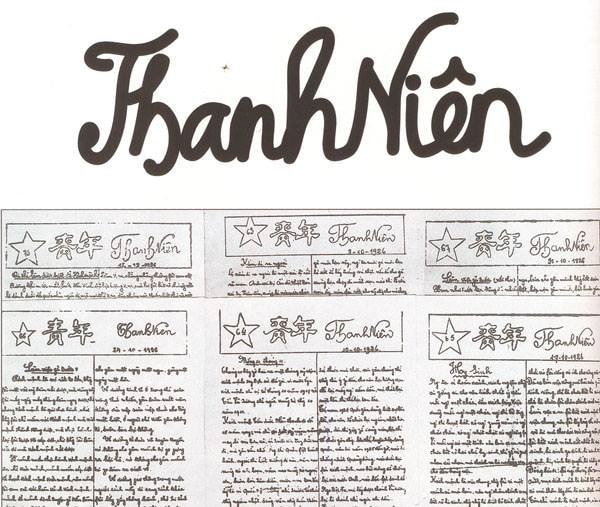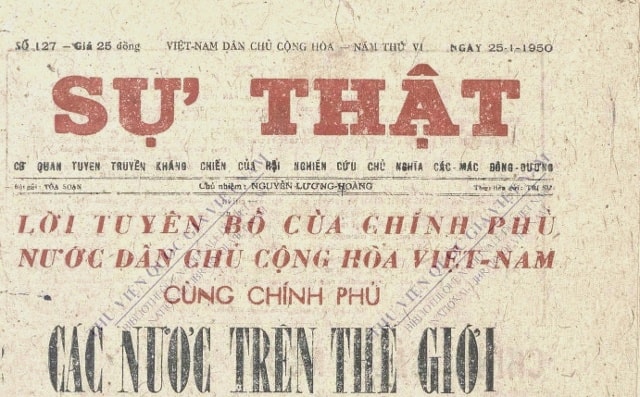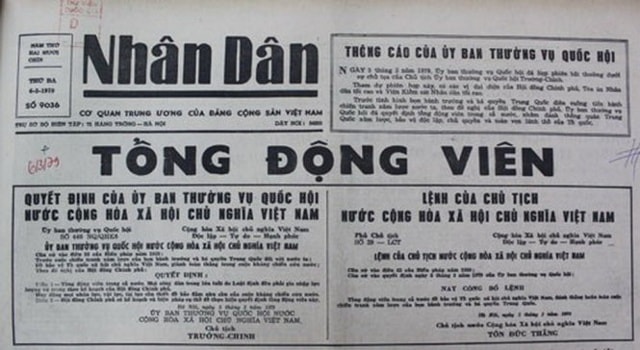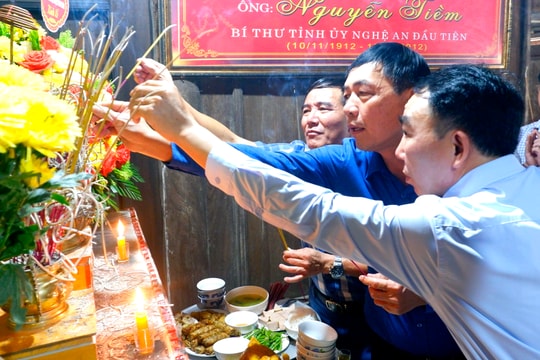Vietnamese Revolutionary Press always accompanies the nation
(Baonghean.vn) - The birth of the Vietnamese revolutionary press with the historical milestone of Thanh Nien newspaper, founded by leader Nguyen Ai Quoc, published its first issue on June 21, 1925, left an indelible mark in the history of the Vietnamese nation.
The Vietnamese Revolutionary Press is the voice of the Party, the State, and political, social, and professional organizations, a trusted forum for the people, and at the same time a sharp weapon against hostile forces of the revolution, fighting against negativity to protect the interests of the people. Over the past 91 years, since the first issue of Thanh Nien (June 21, 1925), the Vietnamese press has continuously developed in a rich and diverse manner.
 |
| Thanh Nien Newspaper - the first newspaper founded by leader Nguyen Ai Quoc in 1925. |
In the early 20s of the 20th century, President Ho Chi Minh founded the Communist Youth Union as the core organization for the Vietnam Revolutionary Youth Association - the first Vietnamese patriotic organization following the path of proletarian revolution, and at the same time published the Thanh Nien newspaper as the mouthpiece of this organization. On June 21, 1925, Thanh Nien, the first newspaper of the Vietnamese Revolution, published its first issue.
In June 1929, the Indochinese Communist Party was born, publishing the Hammer and Sickle newspaper as the Party's Central organ, the Party's Central Labor Movement Committee published the Red Labor Union newspaper, the Northern General Labor Union published the Labor newspaper...
In September 1929, the Annam Communist Party published the Red newspaper. The newspapers of these early communist organizations played a very important role in educating the working masses about class consciousness, class struggle and communist ideals.
In February 1930, the Conference on the Unification of Communist Organizations was convened under the chairmanship of President Ho Chi Minh, decided to establish the Communist Party of Vietnam, passed a number of important documents, and decided that the Central and local governments would publish the newspaper of the unified Communist Party of Vietnam. On August 5, 1930, the Central Committee published the Red Magazine; on August 15, 1930, the Fighting Newspaper was launched.
 |
In October 1930, the Communist Party of Vietnam changed its name to the Communist Party of Indochina. The Party Central Committee published the Proletarian Flag newspaper and the Communist magazine. Regional and provincial committees, many district committees and party cells also published newspapers. The press during this period played an important role in launching the revolutionary movement of workers and peasants against imperialism and feudalism, culminating in the Nghe Tinh Soviet movement.
Also during this period, the Party's Overseas Leadership Committee was established as a temporary task of the Central Committee, publishing the Bolshevik magazine as a theoretical organ to unify the Party. In March 1935, the First Party Congress met and decided to convert the Bolshevik magazine into the Party's Central theoretical magazine.
Communist cells in some large prisons also published newspapers and magazines. The press in the years 1930-1936 actively served the Party building, propagandized Marxism-Leninism and the Party's revolutionary democratic line, resolutely opposed imperialism, feudalism, reformism of the bourgeoisie and bourgeois nationalism of the Vietnam Nationalist Party, preparing conditions to welcome the opportunity to bring the revolution to a new climax.
Taking advantage of favorable international conditions, anti-fascist people's fronts were established in many countries, including France, and the World Anti-Fascist People's Front was formed. Taking advantage of the possibility of operating semi-legally and semi-illegally, the Party advocated publishing newspapers openly and legally. A number of revolutionary newspapers in French were published in Hanoi, along with a series of Vietnamese newspapers that were published openly and legally, including the People's Newspaper, the Central organ of the Party.
Newspapers during the democratic movement printed large quantities of typographical text. One newspaper set a record, such as the Spring 1939 issue of Dan Chung, which printed 15,000 copies. The presentation of articles on the newspaper had a modern appearance, with quick editing and printing, and fast and wide distribution throughout the country and abroad.
In May 1941, the Viet Minh Front was established. In August 1941, the newspaper Vietnam Doc Lap (Independent Vietnam) was founded by President Ho Chi Minh, under the name of Viet Minh Cao Bang province, later expanded to Viet Minh Cao Bang - Bac Can, then Cao Bang - Bac Can - Lang Son.
 |
On January 25, 1942, the newspaper Cuu Quoc, the organ of the Viet Minh headquarters, was born.
On October 10, 1942, the Liberation Flag newspaper, the Party's central organ, published issue 1. The central organ also published the Communist magazine as a theoretical organ. The Viet Minh regional and provincial committees successively published local newspapers along with newspapers of the national salvation organizations at the central level: Workers, Youth, Students, Culture, Self-Defense...
The press actively served the building of the armed forces, combining political struggle with armed struggle. Since the directive to prepare for the uprising from the Viet Minh headquarters (May 1944) and especially after the Japanese-French coup (March 1945), the Party launched a high-level movement to resist Japan and save the country, leading to the General Uprising. A number of newspapers of the armed forces from the anti-Japanese bases and liberated zones were published.
The two newspapers Liberation Flag and National Salvation made the greatest contributions to promoting the revolutionary movement and achieving the historic victory of August 1945.
From the time Thanh Nien newspaper was born until August 1945, there were a total of more than 270 newspapers and magazines.
Press in the period after the August Revolution 1945 to 1975:
From August 1945 onwards, under the people's democratic regime, revolutionary newspapers were published openly, printed in large numbers. The daily newspaper Cuu Quoc was the largest newspaper in the country. Two new agencies appeared in the press: the Voice of Vietnam Radio Station and the Vietnam News Agency (now the Vietnam News Agency). At the end of 1945, the Party went underground, the Liberation Flag newspaper stopped publishing; the Truth newspaper was born under the name of the agency of the Marxist Research Association in Indochina.
During the first years of the revolutionary government, the press actively served the task of protecting the young government.
The second resistance war against French colonialism broke out and spread widely. The revolutionary press had a section published openly in liberated zones and resistance bases, and a section published in enemy-occupied areas. Party documents, speeches and writings by President Ho Chi Minh and other Party leaders were printed in central and local newspapers.
In 1951, Nhan Dan newspaper, the Central organ of the Party, began publishing, Communist magazine, Internal Activities magazine, and People's Army newspaper were born.
The resistance war against French colonialism ended in victory, our country was temporarily divided into two regions with two different strategic missions but a common mission: to overthrow American imperialism and its henchmen, and complete the national liberation revolution.
Our press formed a free press in the North and a press published secretly and illegally in the enemy-occupied areas in the South. Under the new conditions, the press in the North made great strides. Nhan Dan newspaper was published daily, printed in the largest quantity using advanced technology. The Central Committee published a theoretical magazine, initially called Hoc Tap, later changed to Cong San magazine.
 |
On June 2, 1950, the Vietnam Journalists Association was established, widely uniting domestic journalists, and in July 1950 joined the International Organization of Journalists (OIJ).
After the reunification of the country, the press in our country has developed quite rapidly in quantity and quality, forming a system of news agencies, newspapers, radio and television throughout the country. According to recent statistics, the whole country currently has 67 central and local radio and television stations, including 02 national stations: Voice of Vietnam, Vietnam Television, 01 industry station (VTC Digital Television Station); 64 local radio and television stations with 172 radio and television channels (99 television channels, 73 radio channels). Regarding the press staff, the whole country currently has nearly 17,000 professional journalists with cards, 19,000 members of the Vietnam Journalists Association, working in branches, inter-branches...
Press activities in the cause of industrialization and modernization of the country, in the process of international integration and market mechanism, in the era of information explosion are constantly developing. Faced with new requirements, the Vietnamese revolutionary press will forever steadfastly adhere to the ideal goals of the Communist Party of Vietnam, performing well the press function as the mouthpiece of the Party, the State, social organizations and the forum of the people.
Peace(Synthetic)



